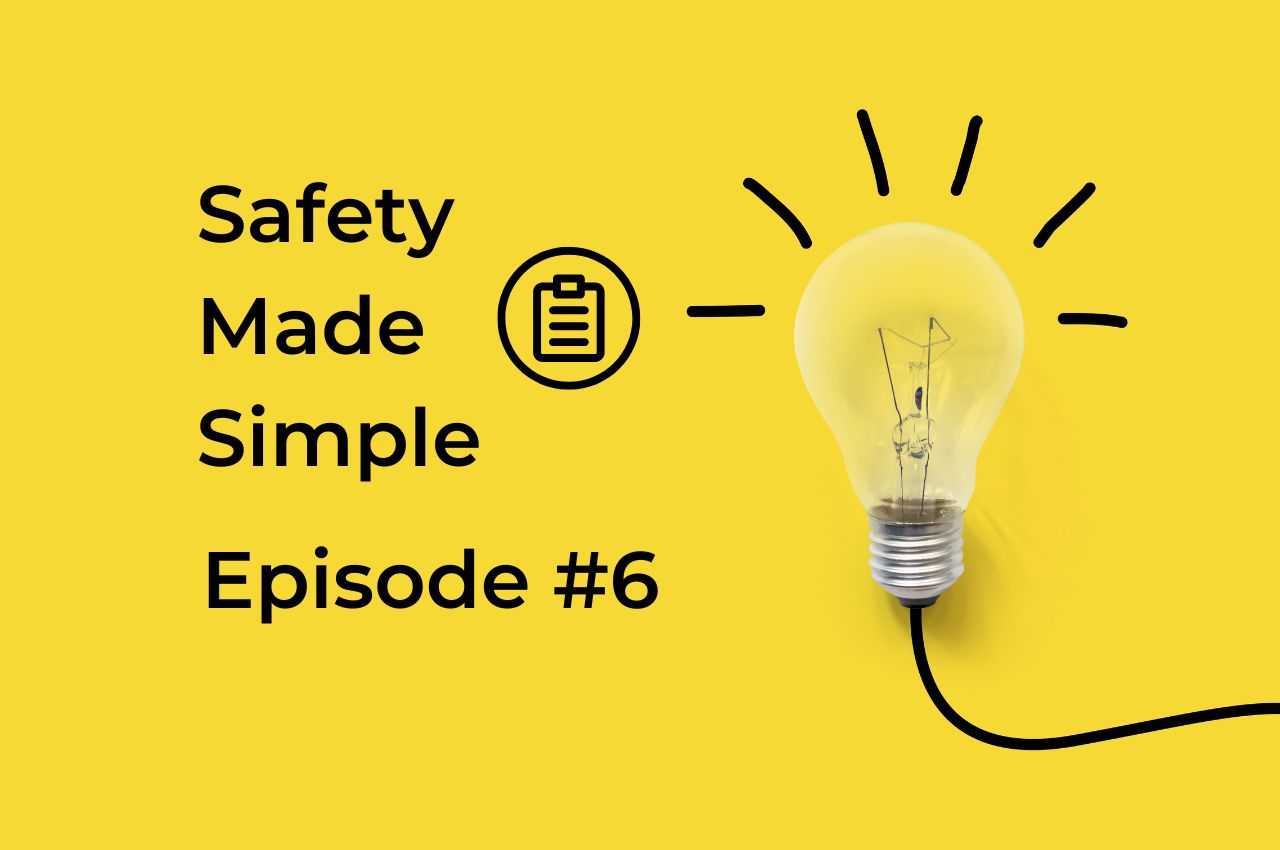
In this episode we look at why we should be reporting and investigating accidents in the workplace, what information should be gathered and looking at the causes of accidents.
If you’d prefer, you can read the transcript here:
Transcript for Ep 6: Accident Reporting and Investigation
Hello, I’m Tom Moon and you are listening to the Praxis42 pint size podcast, where each episode we take a different H&S topic break it down, cut out the jargon and put it into plain English to try and make it easier to understand and easy to implement.
Today we are going to be looking at accident reporting and investigation. Lets get stuck into it.
My experience in health and safety has taught me one thing….. its not if an accident will happen but when it will happen. At the end of the day no matter how many systems we put in place, or how ever long we train staff, or maintain the work place in a safe state we cannot account for human error. We as humans are not robotic, so mistakes will happen, but its how we deal with them that counts.
Admitting when you have done something wrong is not always the easiest thing to do. But what is the key thing when we get something wrong? We learn how to do it right. And this is why accident reporting and investigation plays such a vital role in helping to improve any health and safety management system.
Firstly, let’s look at why we should be reporting and investigating accidents.
So I’ve tried to summarise this into two sections, the first of which is that it ensures you maintain your moral duty of care to your staff and any other persons that could be affected by your work activities. How would it be perceived if your company repeatedly had accidents and no efforts were made to prevent them reoccurring?
Secondly, there is a legal duty under a set of regulations commonly referred to as RIDDOR, or the reporting of incidents, diseases and dangerous occurrence regulations. In basic terms these regs have a set of criteria and if you have any accident that meets them then it must be reported. We will cover this topic in more specific detail in a further episode.
Before we get too far into it we need to make a clear definition of what we are looking to be reported
Firstly it is accidents. Now these are easy to identify as these are events that directly result in injury or ill health.
But the ones that are not commonly looked at or reported are incidents. These are events that didn’t result in injury or ill health but had the potential to. They are those ‘OOO that was close moments!’
And that leads us nicely into why we need a reporting and investigation process.
In basic terms it is an information gathering exercise, so we are looking for the Who? Where? Why? And How?. If we can gather comprehensive information on these areas we can then cross reference it against the existing risk assessments and safe systems of work to identify where potential short comings were. Lets not forget after any accident or incident it should automatically trigger a review of any relevant risk assessment.
Once we know where things have not worked or procedures/assessments were lacking we can look to make improvements; and this maybe to:
- The work process itself
- Adding further control measures
- Staff training
- Equipment used
All of which will go towards preventing the accident occurring again which is the primary aim. If you have an accident in the work place with no serious consequences, take that as the warning. How would it look to have the same accident happen again? Or, how would you feel knowing you had the opportunity to prevent it happening?
It all sounds nice and simple right? It is only going to benefit you and your business if you do it. So why do people fall short in this area and leave themselves open to potential prosecutions and fines or insurance pay-outs.
Well relating this to my experience working in health and safety it comes down to a number of reasons
- People don’t find it easy to admit they got something wrong, or they made a mistake. You can look at this from 2 points of view, either the employee wont report something because they know they weren’t working how they should, or, Management wont investigate the matter fully knowing for well there are short comings in the health & safety management.
- Reporting systems are not in place and people don’t know how to report an accident once it happens.
- Health & safety is not seen as a priority. People’s attitude is one of ‘it won’t happen to me’ or ‘we don’t have accidents’
- People are afraid of reporting accidents/incidents for fear they will be penalised.
The question this raises is How do we get round this?
Firstly, we need a straightforward but comprehensive reporting system. One that gathers all the required information but yet is easy to use and understand. How do we make it easy to use and understand? Well, we train staff. That way they know when an accident or incident form needs to be completed and they know how to complete the form.
What information do we need to gather? Now some of these will be obvious but others not so much, but lets go through it
- Date and time of accident
- Type of accident or incident (collision, impact, fall from height, manual handling, laceration)
- Details of the injured party (name, address, contact details)
- Details of witnesses present
- What work was being completed at the time
- Statement of events (from injured party if possible)
- Witness statements
- What first aid treatment was given (first aid, call for an ambulance)
- You may want to reference any risk assessments related to the task being completed.
- Details of the person completing the form (position, signature and date)
You may be asking what is the best way to gather all this information. Well, there is no hard or fast rule, you can recorded any way you see fit, as along as the relevant information is gathered. Some places I have visited have developed their own in-house forms or electronic systems where others use a printed accident book that can be easily purchased. The level of detail on the reporting forms often is directly related to the risk associated with the work being completed. For example, high risk work such as manufacturing or construction I would expect to see a far more detailed reporting form than say that of a small office.
It should be stressed here that at this stage it should be purely an information gathering exercise. Don’t start looking at potential reasons why it happened or even worse start assigning blame. Identifying causes will all take place during at the investigation stage.
So lets imagine we have an all singing all dancing reporting procedure in place, but how do we get people to report accidents and incidents? As I stated right back at the beginning people don’t always like to admit they got something wrong, or it was their fault. So, it all comes down to having a positive health and safety culture, where people reporting accidents or incidents is welcomed and seen as a positive. If employees can see that when an accident or incident takes place it is managed in the correct manner, rather it just being an exercise of finding the first person to blame, then they will be far more likely to report things when they occur.
One industry that has a positive culture when things go wrong is the aviation industry. All commercial planes are fitted with black box recorders that can record exactly what was being said or done by the crew along with all the technical information regarding the plane. So, if they have an accident they have all the information they need to determine what went wrong and then how to put it right. To work out what went wrong you need to work on fact not presumption.
The accident/incident has been reported now we have to investigate it.
First things first who should investigate the accidents? The biggest mistake would be having just one person conduct the investigation, so we need to gather a team of people who between them have knowledge and experience of not only conducting an investigation but also the work being conducted. With that in mind then let’s assemble our team.
- Manager or supervisor responsible for the work or department where the accident took place. Lets not forget they have a large level of responsibility here and it is a must they are involved
- Member of the safety team or designated health and safety representative in the business. They will bring their health and safety expertise to the table
- Experienced staff who work in the area where the accident/incident took place or carry out the work task that was being completed at the time
- Outside expert. It could be someone like me an H&S Consultant or an industry expert who would have more in-depth knowledge
- Union representative if applicable to your organisation
What we want is a team that bring their knowledge to the table and give a different opinion or point of view on the matter. Having one person complete the investigation who has limited knowledge will hamper your ability to really find the true cause of the accident/incident.
Now are team is assembled it is time to put on the detective hats and try to determine what happened, with the aim of gathering enough information to come to a definite conclusion on what caused the accident/incident to happen.
So the team could divide up here and take on different task but we need to look at the following
- Look at the accident scene. In some serious cases this will have had to be preserved to maintain evidence. But looking at the scene you may identify physical reasons why it happened (poorly maintain workspace etc)
- Examine any equipment that was being used, is it properly maintained? Was the user properly trained?
- Take a statement from the injured party and find out exactly what they were doing
- Take witness statements, find out how they saw things unfold.
- Examine the risk assessments associated with the work being undertaken at the time
You now have the ability to cross reference statements of the injured party with those of the witnesses. You can also see how work was being completed or equipment was being used and reference that against what the risk assessments and safe systems of work say. Slowly you may start to identify some discrepancies, or something may become glaringly obvious.
That’s the information gathering done and with it we can now look at what caused the accident. Lets break this down into the 3 types of causes…..
- Primary cause, what directly caused the accident
- Secondary cause, these could be conditions or behaviours that caused the accident
- And finally, the Underlying cause, this often sits with the management of a task.
Lets put those altogether. Lets take an office environment and someone trips over the damaged carpet and is injured. What is the primary cause? It’s the damaged carpet. Why is the carpet damaged? There is our secondary cause, poorly maintained workplace and lack of ability to repair the carpet. So, what is our underlying cause? Well, we could put it down to there being no risk assessment completed on the work place that could have identified the trip hazards and put in place controls to repair the carpet if it became damaged.
Now here is one of the biggest failings I see in accident investigation, people don’t dig down and identify all the causes. And do you know what will happen because of this? The accident will happen again. Sometimes management do not like to dig down to the underlying cause because they know the buck stops with them and they haven’t done anything about it.
So we are now have all the information available to take appropriate action to prevent the accident happening again and, that is our aim. This process is not about blame. If someone has purposely acted in an unsafe manner well then yes they will have to face the music, but what we want to ensure is ultimately our work force is safe. So what might the information gathered in the investigation enable us to do?
- Review and update risk assessment s and safe working procedures to ensure they are more comprehensive
- Identify further training staff may need to enable them to have a better knowledge of work equipment or work processes
- Changes to equipment so it is safer to use, such as better guarding or further failsafe mechanisms
- Changes to the workplace, better maintenance programmes to repairs issues promptly
To name but a few.
There you have it the accident/incident investigation process in a nutshell. As you can see it is a vital cog in the health and safety management machine and, when done well can give you a wealth of information to prevent it reoccurring.
Remember it is about gathering information and not about assigning blame.
Ensure you have a user-friendly accident/incident reporting system and employees know how it works and when it should be completed. Work on the principles of who? Where? Why? And how?.
It is vital to have an investigation team from all levels of the organisation, all of which have knowledge that adds value to the investigation. It should never be completed by just one person.
Gather all the necessary information for a balanced conclusion to be drawn and look at all causes, primary, secondary, and underlying. Then take the information and act on it, make changes where necessary to documentation, training, equipment etc to achieve the main aim, which is to prevent the accident happening again.
Don’t base it on blame, base it on preventing it happening again.
You’ve been listening to safety Made Simple. Our podcast series helping make the world of health and safety easier to understand and easier to implement. If there’s a topic you’d like us to cover, then please get in touch using the hashtag safety Made Simple, overall website at Praxis42.com.





